Cucurbitaceae
Quick Summary
- Flowers imperfect (flowers are either male or female, different sexes on same plant=monoecious or on different plants dioecious), radially symmetric, epigynous, 5 petals (fused or free), 5 sepals, 5 (sometimes 3) stamen in staminate flower, carpels 3 fused, style single, stigmas 3, inferior ovary
- Fruit a pepo.
- simple, alternate, palmate, tendrils, spiky projections
- About 118 genera and 825 species, mainly in north temperate regions.
Economic plants
Citrullus (watermelon), Cucumis (canataloupe, cucumber, gherkin, honeydew, musk melon), Curcubita (gourds, pumpkins, spaghetti squash, squashes), Lagenia (calabash, bottle gourd), Mormordica (bitter melon), Sechium (chayote)
Flowers
White Bryony (Bryonia dioica)
The roots of this little cucurbit contain powerful chemicals which were used for their purgative qualities.Today, it is considered a poison and not used medicinally. |
 White byrony plant |
| Like other members of the Cucurbitatceae, bryony plants have either male and female flowers. this is a male plant.It is sometimes difficult to tell if the flower is pistillate or staminate. |
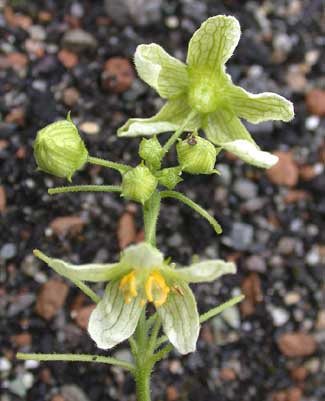 Close-up of white byrony |
| Squash (Cucurbita). Looking down the throat of this squash flower you can see the reproductive structures within. |
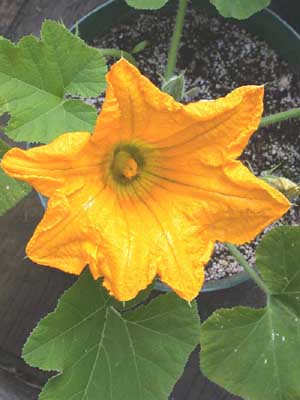 Squash Flower |
| The filaments are fused to make a cone which is capped with the pollen-producing anthers. |
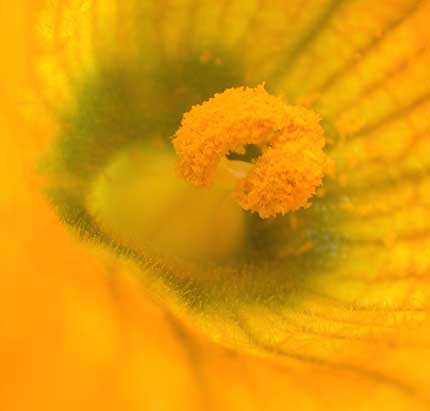 Squash flower, close up |
Cucumber (Cucumis sativus)
Cucumbers have pretty little yellow flowers. Looking down at the face-view of the flower it looks like there are three anthers……but are they? |
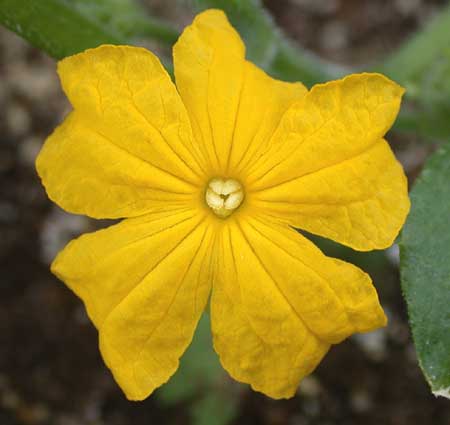 Cucumber flower |
| A side view of the flower reveals the presence of an ovary. This is a pistillate flower. |
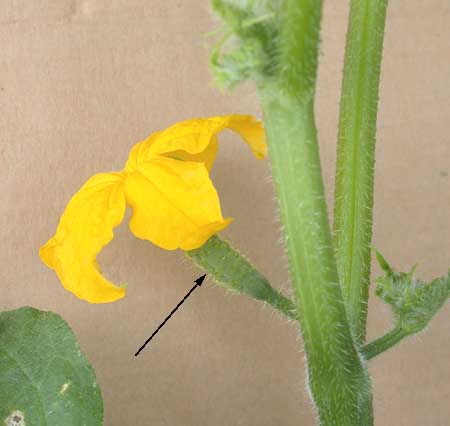 Cucumber flower |
| Remember the best way to examine the parts of the flower are to cut it in half longitudinally. This is an example of an epigynous flower (inferior ovary). |
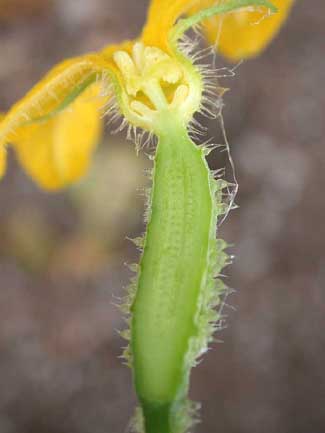 Longitudinal Section of a Cucumber flower |
| Upon closer inspection of the upper part of the flower we can see the style and the very lobed stigma. Although these plants have nectaries, many cucurbits are pollinated by pollen-collecting bees. The stigma is thought to look like anthers to trick such bees into visiting. No reward for those bees!!! |
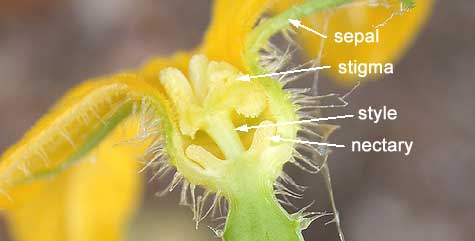 Longitudinal Section, Close up |
| The ovary of the flower is inferior and will ultimately develop into the cucumber we eat. The little nubs that are on the surface of the cucumber are partly due to the remnants of trichomes. |
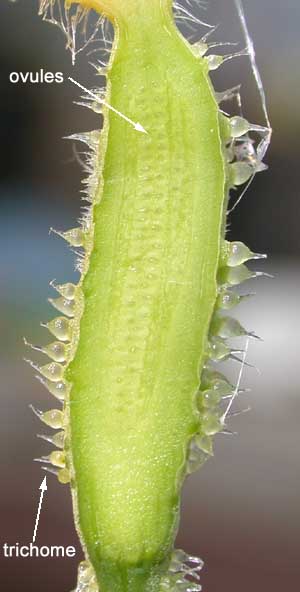 Longitudinal Section, Cucumber flower |
Fruits
pepo = type of berry found in the Cucurbitaceae which has a hard or leathery outer ovary wall (rind) and a fleshy inner ovary wall.
Cucumber (Cucumis sativus)
The mature fruit of the cucumber is pictured below. It is believed to have originated at the foot of the Himalays from a wild cucumber, Cucumis hardwickii. |
|
Cantaloupe (Cucumis melo ‘cantaloup’)
The cantaloup is one variety of the species Cucumis melo. Melons are thought ot have originated from Africa. It is interesting that there is no evidence of them in early Egypt, but rather their introduction to Mediterranean was after the fall of the Roman Empire. |
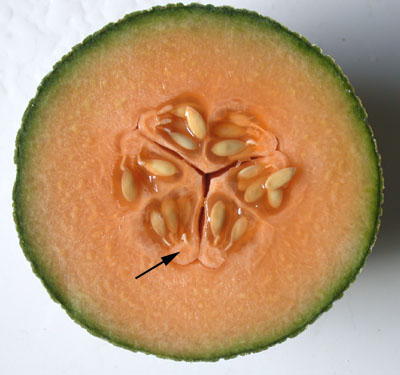 Cantaloupe, Cross section |
Other members of the Cucurbitaceae
| Hubbard Squash (Cucurbita maxima). The hubbard squash is one variety of Cucurbita maxima. Other members of this group include pumpkin, acorn squash, and butternut squash. The species originated in South America, but diifferent varieties are always being developed. They are called winter squashes because they can be stored over the winter. They were important food for the first peoples who had limited food supply over winter months. |
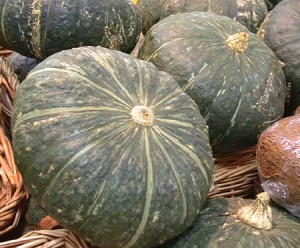 Hubbard Squash |
Watermelon (Citrullus lanatus)
Watermelon is native to tropical and subtropical Africa. It appears to have been domesticated in the Mediteranean. Square watermelons, such as those for sale in the picture below, are not the result of genetic engineering. The fruit is constrained as it grows in a box-like structure. |
 Square-shaped watermelon |
Chayote (Sechium edule)
Chayote was domesticated in Mexico and cultivated for food by the Aztecs. They are generally baked, boiled, or fried. |
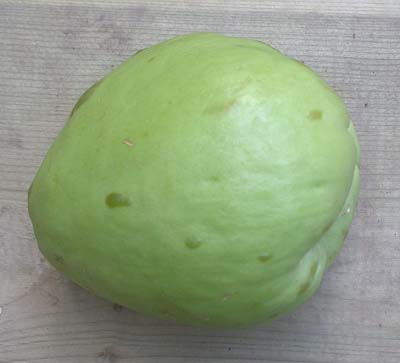 Chayote fruit |
| The fruit is very different from the other members of the Cucurbitaceae. It contains a single seed. |
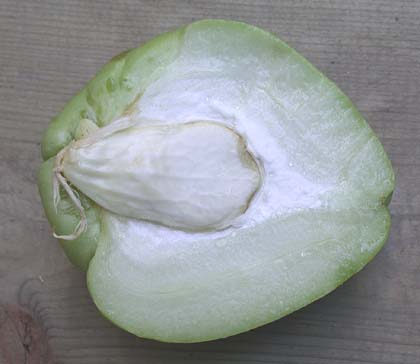 Chayote, seed |
Vegetable Sponge (Luffa cylindrica)
Luffa sponges are coarse when mature and are good scrubbers. When immature luffas are edible. |
 Vegetable Sponge |
Gourds
Gourd is a generaly term used to define members of the Cucurbitaceae with tough rinds which make them useful for containers. One of the most popular is Lageneria siceraria, the bottle gourd. You will see that they have many uses (container, ornament, instrument) as well as food when they are young and tender. |
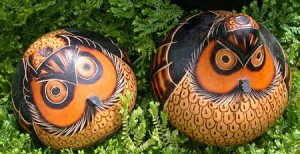 Beautifully carved and dyed gourds of Peru. |
| The gourd container below is from Mexico. |
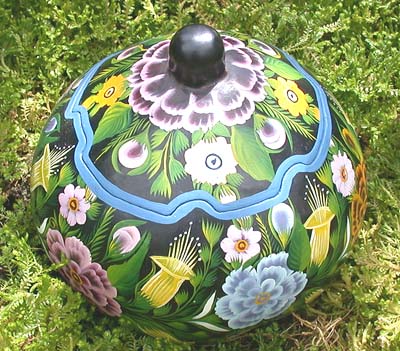 Decorated gourd from Mexico |
| The calabash (Lageneria siceraria) has a long history of use both in the Americas and in Africa. This has presented a mystery to phytogeographers. Where did it originate and how did it get distributed to another continent? |
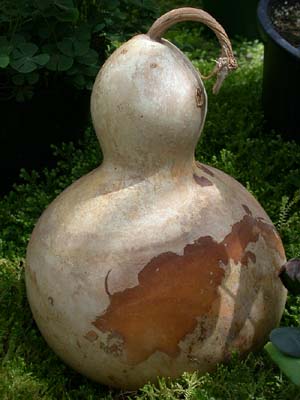 Calabash |
| The African musical instrument pictured below was made by hollowing out a calabash gourd and enclothing it in netted remnants of hard plant material (sometimes beads are used). This is one of many African instruments made from plant material. |
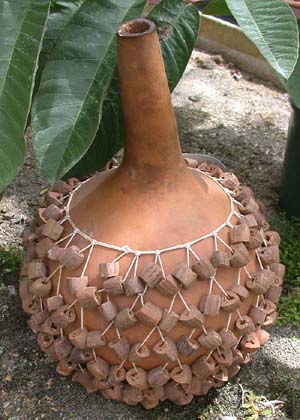 Calabash, made into an instrument |
| The gourd below has been made into a gunpowder container in the style used in Indonesia. |
 Calabash, used to store gunpowder |
| One of the most interesting uses is the penis sheath gourd. The picture below was taken in a marketplace in Papua, New Guinea. These gourds are worn by men as adornment. In the 1970s there were efforts by the Inodnesian government to ban the wearing of the gourd, but this met with such fierce opposition that it was not pursued. Today the gourds are a symbol of defiance against authority and continue to be everyday dress in parts of Papua. Evidence of similar use in South America and Africa have been documented. |
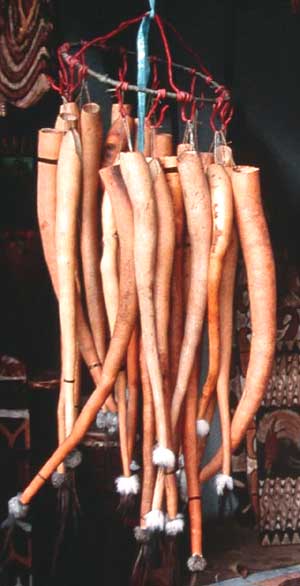 Gourd Slong |
Back to Lab 3






















